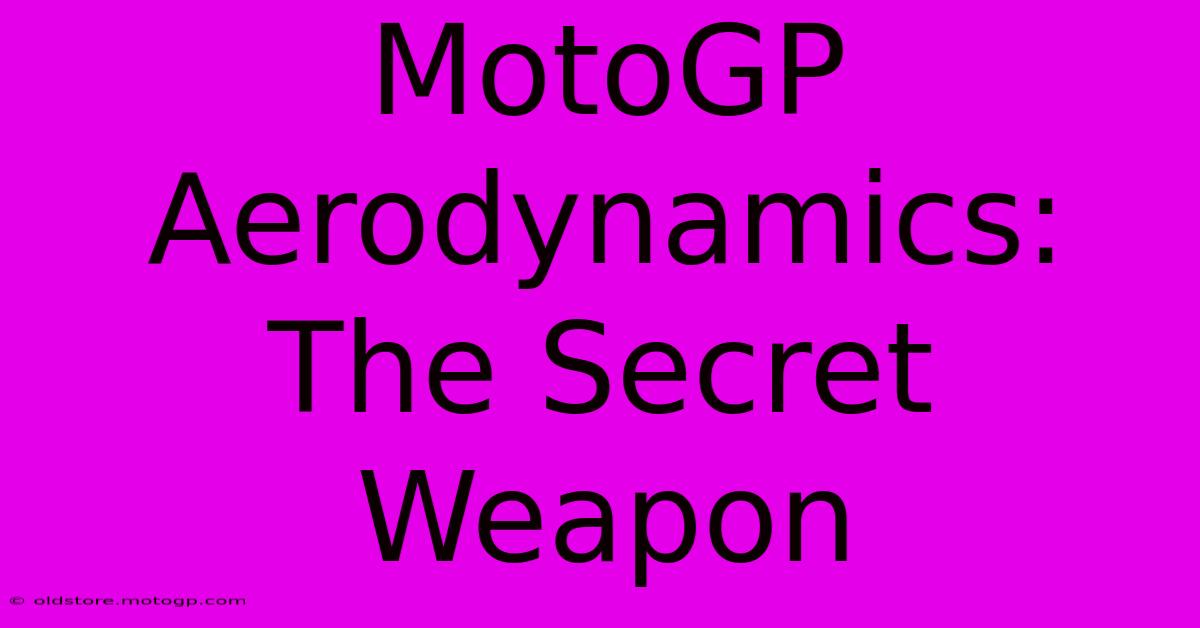MotoGP Aerodynamics: The Secret Weapon

Table of Contents
MotoGP Aerodynamics: The Secret Weapon
MotoGP racing is a relentless pursuit of speed and performance. While rider skill and engine power are crucial, a frequently overlooked but increasingly important factor is aerodynamics. Modern MotoGP bikes are incredibly sophisticated pieces of engineering, and their aerodynamic design plays a vital role in determining race results. This article delves into the complex world of MotoGP aerodynamics, exploring its secrets and its impact on the sport.
Understanding the Importance of Aerodynamics in MotoGP
At speeds exceeding 200 mph (320 km/h), aerodynamic forces become immensely significant. The air resistance, or drag, acting on a MotoGP bike is considerable. Minimizing this drag is crucial for achieving higher top speeds and improved acceleration. But aerodynamics isn't just about reducing drag; it's also about generating downforce.
Downforce: The Grip Advantage
Downforce is the force pushing the bike downwards, essentially "gluing" it to the track. This increased grip is particularly important during cornering, allowing riders to lean into turns at higher speeds and maintain greater stability. Without sufficient downforce, riders would lose control at high speeds, making cornering incredibly challenging and dangerous.
The Aerodynamic Package: Wings, Fairings, and More
The aerodynamic performance of a MotoGP bike is determined by its overall design, but key components include:
-
Wings: These are the most visible aerodynamic elements. They generate downforce, improving stability and allowing for higher cornering speeds. The design and placement of these wings are meticulously engineered, constantly evolving to optimize performance. Different track layouts and conditions require adjustments to wing configurations.
-
Fairings: The bodywork of the bike, or fairing, plays a crucial role in streamlining airflow. Its shape is optimized to minimize drag and guide air around the bike efficiently. Even small changes to the fairing's design can significantly impact overall performance.
-
Aerodynamic Devices: Beyond wings and fairings, manufacturers employ various other aerodynamic devices, such as winglets, diffusers, and other subtle components. These elements work in conjunction to fine-tune the airflow and maximize downforce while minimizing drag.
The Constant Evolution of MotoGP Aerodynamics
Aerodynamic technology in MotoGP is in a state of constant evolution. Teams and manufacturers are continuously experimenting with new designs and materials to gain even the smallest performance advantage. Computational Fluid Dynamics (CFD) simulations play a critical role in this development process, allowing engineers to virtually test and refine designs before physical prototyping.
Wind Tunnel Testing: Real-World Refinement
While CFD provides valuable insights, wind tunnel testing remains indispensable. These tests allow engineers to observe the airflow around the bike in real-world conditions, refining designs based on actual data. Wind tunnels are essential for verifying the accuracy of CFD simulations and making fine adjustments to the aerodynamic package.
The Impact on Racing Strategy
The effectiveness of a bike's aerodynamics directly impacts racing strategy. A bike with superior aerodynamic performance can maintain higher speeds on straights, allowing for better overtaking opportunities and a stronger advantage during the race. Furthermore, the ability to maintain high cornering speeds thanks to downforce translates into faster lap times and a greater chance of victory.
Conclusion:
Aerodynamics is no longer a secondary consideration in MotoGP; it is a crucial element that separates winning teams from the rest. The constant development and refinement of aerodynamic technologies highlight the importance of this often-overlooked aspect of the sport. The intricate interplay of drag reduction and downforce generation continues to shape the exciting and ever-evolving landscape of MotoGP racing. As technology continues to advance, we can expect to see even more sophisticated aerodynamic solutions deployed on the track, pushing the boundaries of speed and performance further than ever before.

Thank you for visiting our website wich cover about MotoGP Aerodynamics: The Secret Weapon. We hope the information provided has been useful to you. Feel free to contact us if you have any questions or need further assistance. See you next time and dont miss to bookmark.
Featured Posts
-
Cota Parking Find Your Perfect Parking Spot With Our Map
Feb 24, 2025
-
Moto Gp Watch Free Streaming Options
Feb 24, 2025
-
Austin F1 Shuttle The Best F1 Experience Starts Here
Feb 24, 2025
-
Cota Parking The Austin Map That Works
Feb 24, 2025
-
Against The Odds Who Triumphed In The Grand Prix
Feb 24, 2025
